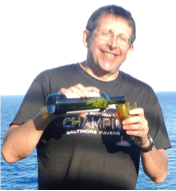Optics Seminar
How small can one shrink a laser?
Add to Google Calendar

Recently there has been a surge in activity devoted to development of the nano-scale lasers, in particularly the lasers employing surface-plasmon polaritons in metal dielectric structures ("spasers"). In my talk I will review the recent effort and present a theory that would clearly outline the fundamental limits of how small can the nano-laser actually be. First I will show that in order to go beyond diffraction limit one absolutely must use metallic structures with associated loss. Then I will show that the lasing threshold of the single mode metal-semiconductor nano-laser (spaser) is determined only by the photon absorption rate in the metal and exhibits very weak dependence on the composition, shape, size (as long as it is less than half-wavelength) and temperature of the gain medium. This threshold current is on the order of a few tens of micro-amperes for most semiconductor-metal combinations which leads to unattainably high threshold current densities for a substantially subwavelength laser (spaser). I will also discuss the coherence properties of nano-laser, and the modulation speed, which is comparable to that of a standard VCSEL. Therefore, in my view, surface plasmon emitting diodes, (SPED's), operating far below "spasing" threshold may be a more viable option for the chip scale integrated nanophotonics.
Jacob B. Khurgin had graduated with MS in Optics from the Institute of Fine Mechanics and Optics in St Petersburg, Russia (now called something else) in the previous millennium (1979), and shortly thereafter, in 1980 he had emigrated to US, where, to his own greatest surprise, he almost immediately landed what at a time seemed to be a meaningful job with Philips Laboratories of NV Philips in Briarcliff Manor, NY. There for 8 years he worked with various degrees of success on miniature solid-state lasers, II-VI semiconductor lasers, various display and lighting fixtures, X-ray imaging, and, more important, on small appliances such as electric shavers and coffeemakers (for which he holds 3 patents). Simultaneously he was pursuing his graduate studies at Polytechnic Institute of NY (nowadays elevated to NYU School of Engineering) where he had received PhD in Electrical Engineering in Jan. 1987. In Jan. 1988, prompted by a promotion to a Department Manager, Khurgin's industrial career came to an abrupt end, and he had joined the ECE department of Johns Hopkins University, where, despite his ever present reservations about that place, he had settled down and is currently a Professor. His research topics over the years included an eclectic mixture of optics of semiconductor nanostructures, nonlinear optical devices, lasers, optical communications, THz radiation, microwave photonics, cavity optomechanics, slow light propagation, and rudimentary condensed matter physics. Currently he is working in the areas of mid-infrared lasers and detectors, phonon engineering for high frequency transistors, disorder in condensed matter physics, plasmonics (or lack of such), coherent secure optical communications, and silicon photonics. His publications include 6 book chapters, one book edited, 240 papers in refereed journals and 28 patents. Prof Khurgin had held a position of a Visiting Professor in an array of institutions of variable degrees of repute "“ Princeton, UCLA, Brown, Ecole Normale Superieure (Paris), Ecole Polytechnique (Paris) , EPFL (Lausanne), and so on. Prof. Khurgin is a Fellow of American Physical Society and Optical Society of America.
 MENU
MENU 
